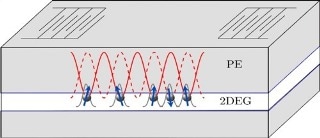Nov 15 2017
The potential to trap and control electrons and other quasi-particles in order to study isolated single particles and also many-body systems in a solid-state environment can be of great importance for understanding the behavior of correlated electrons in technologically applicable materials.
When compared to atoms, these point-like particles are very fast and mobile due to their very small masses. This indeed makes them hard to hold in place. Presently, an international team of scientists headed by Prof. Ignacio Cirac (Max Planck Institute of Quantum Optics, Garching), and Prof. Mikhail Lukin (Harvard University, USA) have explored a new way of building a cage for electrons (Physical Review X 7, 24 October 2017). Based on their proposal, electrons can be moved or held in place by electric potentials that are produced by acoustic waves on the surfaces of piezoelectric materials. Additionally, the usage of counterpropagating acoustic waves leads to be the production of lattice structures similar to optical lattices for neutral atoms.
 In a piezo-electric solid (PE), counter-propagating surface-acoustic waves generate a time-dependent, periodic electric potential for electrons confined to a two-dimensional plane, i.e. a two-dimensional electron gas (2DEG); the resulting acoustic lattices are one- or two-dimensional, depending on the geometry of the setup. At high SAW frequencies, the potential can be effectively described by a time-independent pseudo-lattice. The motion of electrons at potential minima can be described by a harmonic oscillator, superimposed by small-amplitude, high-frequency micro-oscillations. (Graphic: from the original publication / teaser: Bernadette Brunner)
In a piezo-electric solid (PE), counter-propagating surface-acoustic waves generate a time-dependent, periodic electric potential for electrons confined to a two-dimensional plane, i.e. a two-dimensional electron gas (2DEG); the resulting acoustic lattices are one- or two-dimensional, depending on the geometry of the setup. At high SAW frequencies, the potential can be effectively described by a time-independent pseudo-lattice. The motion of electrons at potential minima can be described by a harmonic oscillator, superimposed by small-amplitude, high-frequency micro-oscillations. (Graphic: from the original publication / teaser: Bernadette Brunner)
On the one hand, the scientists offer a general theoretical framework with guidelines in order to meet the essential requirements for an experimental realization. They examine the potential of particular layered semiconductor devices as experimental platforms.
Besides being the fundamental interest for the controlled study of quasi-particles in solid-state settings, the intended setup represents a fresh way for quantum simulations of condensed matter, with the ultimate potential to study parameter regimes that are yet to be explored, thanks to particular system properties such as intrinsic electron-phonon cooling, ultra-light particle masses and strong inter-particle interactions.
The fundamental setup described in the paper comprises of a layered structure: a thin, quasi two-dimensional film of a semiconducting material such as gallium arsenide, deposited on a substrate, is covered with a piezoelectric material. Two “interdigital transducers” (IDTs), consisting each of two thin film electrodes, are patterned on its surface. They produce counterpropagating “surface acoustic waves” (SAWs), which in turn persuade a time-dependent periodic electric potential. This reacts on the electrons that are limited in the semiconducting layer. The probable depth is controlled by the power, the lattice spacing by the frequency of the voltage used on the IDTs.
SAWs have earlier been employed successfully in order to change the position of an electron or to trap it for the few nanoseconds it takes the soundwaves to ripple along the surface. Instead, the new approach proposes a quasi-stationary trapping potential.
If the frequency of the sound wave is high enough, the electron’s potential landscape can effectively be described by a time-independent pseudolattice. The electrons cannot adiabatically follow the rapidly oscillating force, and so they will effectively be trapped close to a potential minimum.
Johannes Knörzer, Doctoral Candidate in the Theory Division of Prof. Cirac at MPQ
One focus of the paper refers to the description of in depth conditions for dynamically trapping and then cooling single particles in SAW-induced potentials. “The calculations imply, for example, that a very low temperature is required. Our theoretical treatment is, to some extent, reminiscent to that of trapped ions,” Johannes Knörzer points out. The other focus refers to the simulation of quantum many-body systems by a system of electrons caught within acoustic lattices.
The effective dynamics of the electrons in the sound lattices can be captured by the Fermi-Hubbard model, very much like for fermionic ultracold atoms in optical lattices.
Johannes Knörzer
The team examines the viability of the concept for varied heterostructures capable of supporting high-velocity sound waves. The calculations apply to electrons and also to a wide range of “quasiparticles”, such as holes or excitons, that arise in modern solid-state systems. “The wish to gain deeper insight into the properties and interactions of these particles is our motivation to search for trapping mechanisms that bring the generality and flexibility of optical lattices to the solid-state setting,” resumes Prof. Ignacio Cirac. “Our ultimate goal is to understand the behaviour of correlated electrons in technologically relevant materials and molecules. This would pave the way towards building a universal quantum simulator.”